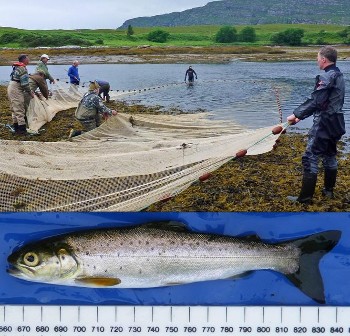A generally better summer for wild sea trout around Wester Ross
Posted: Wednesday 20 August, 2014 @ 17:28:14

Current indications are that sea trout around most of the Wester Ross area have had a more successful summer in 2014 than in 2013.
With fewer ‘early returned’ sea trout in river estuaries, WRFT sweep netting teams had to work harder to catch useful samples at sites around Wester Ross in June and July 2014 than in 2013. In the Kanaird estuary, only 10 sea trout were caught on 16th June, all but one of which were ‘post-smolts’ of less than 25cm in length; most of these fish had no lice on them. On 14th July, numbers of sea lice were higher; three fish out of a sample of 20 fish carried more than 50 lice including one with more than 100 lice.
At Dundonnell there were only two sea trout taken in the fyke net set in the estuary to catch early returned sea trout in June and early July 2014. During the same period in 2013, 78 sea trout were caught carrying an average of over 100 lice each. Samples of sea trout were also taken using the sweep net at the head of Loch Little Loch Broom, including 10 fish on 15th July 2014, all of which had less than 5 lice per fish, except one which carried 164 lice.
In Loch Ewe, very few fish were caught despite much effort. Over three midgy evening sweep netting sessions (two in June and one in July), only nine sea trout were caught. They included the largest fish we’ve seen at the site; a sea trout of 525mm (1580g). None of the sea trout sampled carried more than 15 sea lice. However, nearby using rod and line on 8th July, 10 sea trout of between 20cm and 31cm in length were taken in the River Ewe; they carried an average of 16 lice.
In Loch Gairloch (sweeps on 12th June, 28th June and 10th July) very few lice were seen on a combined sample of just 19 small sea trout (of mostly less than 20cm in length) taken in the estuary. The average number of lice on these fish was less than one per fish.
In early August, sea trout of up to 2lb were taken in the Tournaig upstream trap (for fish entering freshwater from the sea). Sea trout of up to 4.5lb were taken in the River Ewe – Loch Maree system by anglers, including a catch of 10 of up to 1.5lb (along with brown trout of up to 2lb+) from the Loch Maree Hotel. 140 ‘plump’ finnock carrying few sea lice were taken from the River Carron between July and early August; and larger sea trout of up to 3lb.
Interpretation
Our information on sea trout for Wester Ross correlates with lower numbers of adult sea lice on salmon farms within the area during the spring and early summer of 2014 than during the same period in 2013 as reported in SSPO fish health reports. It also correlates with improved breeding success of sea birds at St Kilda and other sites around Scotland; in Loch Ewe terns fledged at least 12 chicks at Mellon Charles where they failed to breed in 2013. Shoals of sandeels, small pollack and small cod were seen by the WRFT Biologist, snorkelling in Little Loch Broom, Gruinard Bay and Loch Ewe.
Rather than ‘returning early’ to freshwater to rid themselves of sea lice, our findings suggest that a majority of sea trout around Wester Ross were able to disperse around the coast and find food, and grew well, thus demonstrating the potential for a recovery of the once prolific sea trout fisheries of the area such as Loch Maree.
However, further south sea trout may have fared less well. According to the SSPO fish health report for the 2nd quarter of 2014 , average numbers of sea lice on large salmon farms in the Loch Alsh – Duich area (with a total consented biomass of farmed salmon of over 6,500 tonnes) greatly exceeded SSPO Code of Good Practice targets for April, May and June 2014.
WRFT remains concerned. Many of the salmon farms around Wester Ross will be in the second year of production in 2015. The salmon farming industry has yet to demonstrate that it is able to retain control of sea louse populations during the second year of the farm salmon production cycle.
Additional samples of sea trout may be taken before the end of the season to gain more information about the status and health of local populations. Please contact the WRFT biologist if you would like to help.
Sweep netting was supported by the Scottish Government via the RAFTS Managing Interactions with Aquaculture Project, the Wester Ross Area Salmon Fishery Board, many estates and their staff, many volunteers including members of Ullapool and Achiltibuie angling club and local fish farm staff. Thank you to all.
Peter Cunningham, info@wrft.org.uk